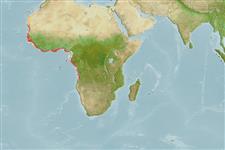Common names from other countries
Classification / Names / Names
ماع يماسا | فدارتم | Catalog of Fishes (gen., sp.) | ITIS | CoL | WoRMS
Environment: milieu / climate zone / depth range / distribution range
يسانش موب
; قمع تارييغت 17 - 160 m (Ref. 275), usually 70 - 140 m (Ref. 275). Tropical; 28°N - 13°S, 21°W - 14°E (Ref. 1695)
Eastern Atlantic: from Canary Island and Guinea Current to Angola.
Length at first maturity / Size / Weight / نس
Maturity: Lm ? range ? - ? cm Max length : 18.0 cm ML يسنج صاوخ نودب / رن سنج; (Ref. 1695); 13.4 cm ML (female)
Maximum size for male/unsexed is 18 cm, mantle length (Ref. 104052). Minimum depth from Ref. 91331. Feeds on molluscs (including other cephalopods), crustaceans and small fishes (Ref. 275).
Life cycle and mating behavior
غولب | لثم دیلوت | یزیر مخت | اه مخت | Fecundity | )ورال ( دازوت
Members of the class Cephalopoda are gonochoric. Male and female adults usually die shortly after spawning and brooding, respectively. Mating behavior: Males perform various displays to attract potential females for copulation. During copulation, male grasp the female and inserts the hectocotylus into the female's mantle cavity where fertilization usually occurs. Life cycle: Embryos hatch into planktonic stage and live for some time before they grow larger and take up a benthic existence as adults.
یلصا ذخآم
عجارم | هدننك گنهامه | ناراكمه
Jereb, P. and C.F.E. Roper (eds.). 2005. (Ref. 1695)
NCUI زمرق تسرهف رد تيعضو (Ref. 130435)
ستياس رظن زا تيعضو (Ref. 108899)
Not Evaluated
Not Evaluated
یناسنا هدافتسا
تاليش – يريگ يهام: يراجت
| FIRMS (Stock assessments) | FishSource |
اهرازبا
رتشيب تاعالطا
Age/Sizeدشرنزو - لوطلوط - لوطيسانش تخير)ورال ( دازوتيناوارف
يتنرتنيا عبانم
Estimates based on models
Preferred temperature
(Ref.
115969): 15.1 - 17.3, mean 16.3 (based on 26 cells).
یريذپ بيسآ
Low vulnerability (10 of 100).
